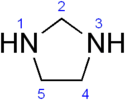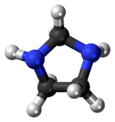Imidazolidine
| |||
| Names | |||
|---|---|---|---|
| Preferred IUPAC name
Imidazolidine | |||
| Other names
Tetrahydroimidazole 1,3-diazolidine | |||
| Identifiers | |||
| 504-74-5 | |||
| 3D model (Jmol) | Interactive image | ||
| ChemSpider | 396007 | ||
| PubChem | 449488 | ||
| |||
| |||
| Properties | |||
| C3H8N2 | |||
| Molar mass | 72.109 | ||
| Supplementary data page | |||
| Refractive index (n), Dielectric constant (εr), etc. | |||
| Thermodynamic data |
Phase behaviour solid–liquid–gas | ||
| UV, IR, NMR, MS | |||
| Except where otherwise noted, data are given for materials in their standard state (at 25 °C [77 °F], 100 kPa). | |||
| | |||
| Infobox references | |||
Imidazolidine is a heterocyclic compound (CH2)2(NH)2CH2. The parent imidazolidine is lightly studied, but related compounds substituted on one or both nitrogen centers are more common. Generally, they are colorless, polar, basic compounds. Imidazolidines are cyclic 5-membered examples of the general class of aminals.
Preparation
Imidazolidines are traditionally prepared by condensation reaction of 1,2-diamines and aldehydes. Most commonly, one or both nitrogen center is substituted with an alkyl or benzyl (Bn) group:[1]
- (CH2NBn)2 + PhCHO → (CH2NBn)2C(H)Ph + H2O
The first unsubstituted imidazolidine synthesis was reported in 1952.[2]
Reactions
Unsubstituted imidazolidines are often labile.[3] The rings are susceptible to hydrolysis back to the diamine and the aldehyde.[1]
Formally, removal of the two hydrogens at carbon 2 (between the two nitrogens) would yield the carbene dihydroimidazol-2-ylidene. Derivatives of the latter comprise an important class of persistent carbenes.[4]
Related imidazole-derived heterocycles
Classified as a diamine, it is formally derived by the addition of four hydrogen atoms to imidazole. The intermediate, resulting from the addition of only two hydrogen atoms is called imidazoline (dihydroimidazole). The connection of imidazolidine to related compounds is indicated in the Figure.

References
- 1 2 Ferm, R. J.; Riebsomer, J. L. From "The chemistry of the 2-imidazolines and imidazolidines" Chemical Reviews, 1954, 54, 593-613. doi:10.1021/cr60170a002
- ↑ E. D. Bergmann; E. Meeron; Y. Hirshberg; S. Pinchas (1952). "Reaction products of primary β-hydroxy-amines with carbonyl compounds. IV. Infrared and ultraviolet absorption spectra of ethylenediamine derivatives". Rec. Trav. Chim. 71 (2): 200–212. doi:10.1002/recl.19520710211.
- ↑ Madeleine M. Joullie; George M. J. Slusarczuk; Adrienne S. Dey; Paul B. Venuto; Ronald H. Yocum (1967). "Synthesis and properties of fluorine-containing heterocyclic compounds. IV. N,N-Unsubstituted imidazolidine". J. Org. Chem. 32 (12): 4103–4105. doi:10.1021/jo01287a100.
- ↑ A. J. Arduengo; H. V. R. Dias; R. L. Harlow; M. Kline (1992). "Electronic stabilization of nucleophilic carbenes". J. Am. Chem. Soc. 114 (14): 5530. doi:10.1021/ja00040a007.

